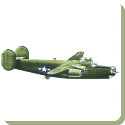 B-24 Liberator — The Consolidated B-24 Liberator was, with the B-17 Flying Fortress, the primary long-range bomber aircraft of the U.S. Army Air Force during World War II. Although the B-17 achieved greater fame, the B-24 was built in greater numbers than any other American aircraft, with more than 18,000 Liberators and Liberator variants being manufactured before the end of the war.
B-24 Liberator — The Consolidated B-24 Liberator was, with the B-17 Flying Fortress, the primary long-range bomber aircraft of the U.S. Army Air Force during World War II. Although the B-17 achieved greater fame, the B-24 was built in greater numbers than any other American aircraft, with more than 18,000 Liberators and Liberator variants being manufactured before the end of the war.
The Consolidated B-24 Liberator was a four-engined American heavy bomber that was built by Consolidated Aircraft Company. It was produced in greater numbers than any other American combat aircraft during World War II and still holds the record as the most produced US aircraft. It was used by every branch of service during the war, attaining a distinguished war record with its operations in the European, Pacific, African and Middle Eastern theaters.
Often compared to its more famous partner, the B-17 Flying Fortress, the B-24 was a more modern design with a higher top speed, and greater range yet it had a similar bombload and massive defensive armament. Nevertheless, popular opinion among aircrews and general staff tended to favor the B-17’s rugged qualities above all other considerations. Where the B-24 excelled over other contemporary World War II heavy bombers was in its versatility.
Development
The Liberator’s origins stem from a USAAC request in 1938 for Consolidated to produce the B-17 under license as part of the “Project A” program for industrial expansion and production to supplement the manufacturing of key components of air power. After company executives including President Reuben Fleet visited the Boeing factory in Seattle, a decision was made to submit a more modern design instead. In January 1939, the United States Army Air Corps formally invited Consolidated Aircraft under Specification C-212, to submit a design study for a bomber with greater range, higher speed and greater ceiling than the B-17.
The contract for a prototype was awarded in March 1939, with the requirement that a prototype be ready before the end of the year. The design was simple in concept but advanced for its time. Compared to the B-17 Flying Fortress, the proposed Model 32 was shorter, had 25% less wing area but a six foot (1.8 m) greater wingspan and a substantially greater carrying capacity. Whereas the B-17 used 9-cylinder Wright R-1820 Cyclone engines, the Consolidated design would use twin-row, 14-cylinder Pratt & Whitney R-1830 Twin Wasp radials of 1000 hp (746 kW). The 70,547 lb (32,000 kg) maximum takeoff weight was one of the highest of the period. Consolidated also incorporated innovative features: the new design would be the first American bomber to use tricycle landing gear and it had long, thin wings with the efficient “Davis” high aspect ratio design promising to provide maximum fuel efficiency. The aircraft also had a distinctive twin tail and rudder assembly.
Due to the sophisticated design elements, wind tunnel testing and experimental programs utilizing an existing Consolidated Model 31, a twin-engined commercial flying boat, provided extensive data on the flight characteristics of the Davis airfoil.
Consolidated finished the prototype, by then known as the XB-24, and had it ready for its first flight two days before the end of 1939. Seven more YB-24 development aircraft flew in 1940 and Consolidated began preparing production tooling. Early orders—placed before the XB-24 had flown—included 36 for the United States Army Air Corps, 120 for the French Armée de l’Air and 164 for the RAF. Most of the first production B-24s went to Britain, including all those originally ordered by the Armée de l’Air after France collapsed in 1940. The name, “Liberator” was initially assigned to the RAF and subsequently was adopted by the USAAC as the official name for the type.
 Kids Portal For Parents India Kids Network
Kids Portal For Parents India Kids Network
